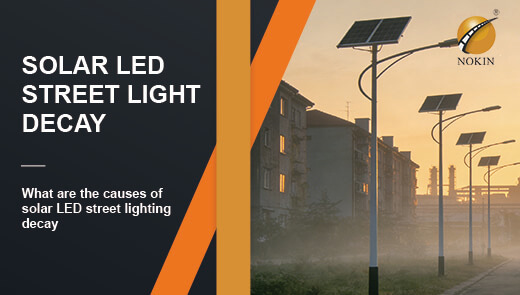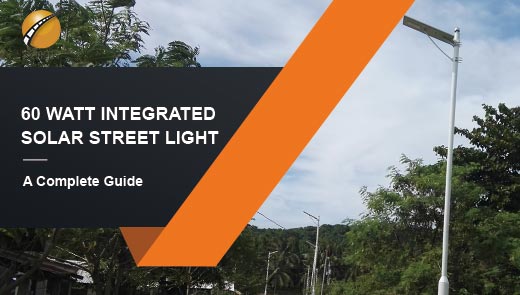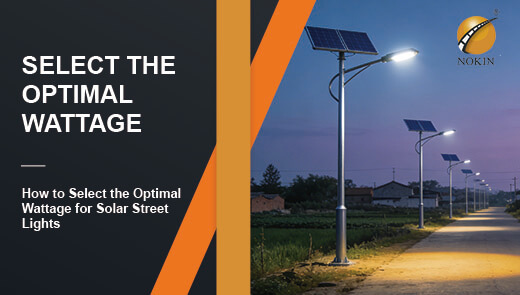Industrial Solar Street Lights: A Complete Guide
In industrial and commercial scenarios, the lighting requirements in areas such as factory roads, logistics parks, and port cargo yards not only concern operational efficiency but also affect cost control. Traditional municipal street lights not only face high electricity bills but also have problems such as complex wiring and cumbersome operation and maintenance. Next, NOKIN will focus on the application of industrial solar street lights, dissecting their commercial value and key points of implementation from core dimensions such as energy-saving costs, stability guarantees, scientific selection, and efficient maintenance. Data shows that installing solar street lights in industrial scenarios can reduce lighting energy consumption and operation and maintenance costs by over 60%, making it an important choice for enterprises to cut costs and reduce carbon emissions.
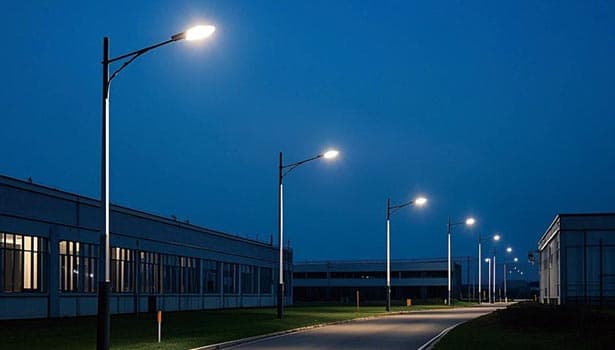
What is an Industrial Solar Street Light?
Industrial solar street lights are an integrated lighting system that combines high-efficiency solar panels, long-cycle lithium batteries, intelligent controllers, high-power LED light sources and high-strength light poles. They achieve self-power supply through solar photovoltaic conversion.
Compared with civilian street lights, industrial solar street lights have significant differences: they have stronger weather resistance and can adapt to harsh environments such as high temperature, high humidity and much dust in industrial areas. The protection level is higher, with IP65 or above waterproof standards and a high IK collision resistance level becoming the basic configuration. The requirements for power and battery life are more stringent, meeting the needs of large-area and long-duration lighting. Supports intelligent management and is adapted to the remote monitoring and precise regulation requirements of industrial scenarios.
Industrial Solar Street Light Application Scenarios
Lighting on the Main and Secondary Roads within the Factory Area
The main roads in the factory area need to meet the high illuminance requirements for large vehicles to pass through at night, while the secondary roads focus on lighting for personnel inspection. Solar street lights do not require the excavation of road surfaces to lay cables, making them particularly suitable for the renovation of old factory areas and significantly reducing the interference of construction on production.
Logistics/Loading and Unloading Area and Cargo Yard Lighting
The loading and unloading area and the cargo yard need 24-hour continuous lighting. The long-range design of solar street lights can ensure the safety of night operations. Its rapid deployment feature can meet the temporary expansion needs of the freight yard and avoid the delay of the construction period caused by traditional cabling.
Large Parking Lots and Staff Access Areas
The lighting coverage of large commercial or industrial parking lots is extensive. Solar street lights, through human body sensing and timed dimming functions, reduce power during off-peak hours, balancing energy conservation and safety. The employee passage area can enhance the comfort of walking at night by using soft color temperatures.
Port, Factory Perimeter and Security Monitoring Supplementary Lighting
The lighting around ports and factories needs to take into account the supplementary lighting requirements for security monitoring. The high color rendering feature of industrial solar street lights can enhance the clarity of the monitoring images. In remote peripheral areas without power grid coverage, the independent power supply advantage of solar street lights is particularly prominent.
Temporary/Remote Construction and Remote Facilities
Temporary scenarios such as road construction and mining, as well as remote facilities like communication base stations and hydrological monitoring points, have flexible lighting requirements and no fixed power grid support. Solar street lights are easy to install and highly mobile, and can quickly adapt to temporary lighting needs.
5 Advantages of Using Industrial Solar Street Light
Significant Cost Savings
Industrial solar street lights can completely eliminate the cost of lighting electricity and at the same time save the initial engineering costs such as cable laying and trench excavation of traditional street lights. In the long term, its investment payback period is usually 3 to 5 years, and it can achieve low-cost operation for nearly a decade subsequently, with excellent ROI performance.
Green, Low-carbon and Compliant
Solar street lights operate with zero emissions and zero pollution, which can effectively reduce the carbon footprint of enterprises. Under the global "dual carbon" goals, deploying solar lighting systems can help enterprises meet environmental compliance requirements and enhance their image of sustainable development.
Flexible and Efficient Deployment
For remote areas without power grids or temporary engineering projects, solar street lights do not rely on municipal power supply, and the installation period can be shortened by more than 50%. Enterprises can flexibly increase or decrease lighting points according to the needs of production expansion to adapt to dynamic operation scenarios.
The Operation and Maintenance Costs have been Reduced
The core components of high-quality industrial solar street lights have a lifespan of 5 to 10 years and do not require frequent manual inspections. Only regular cleaning of the solar panels and inspection of the battery status are required. The operation and maintenance frequency is much lower than that of traditional street lights, significantly reducing labor costs.
Intelligent and Efficient Control and Management
Modern industrial solar street lights integrate intelligent functions such as MPPT controllers, human body sensing, and remote monitoring, and can meet management needs such as on-demand dimming, fault early warning, and data statistics. Further enhance energy utilization efficiency and extend equipment lifespan through intelligent regulation and control.
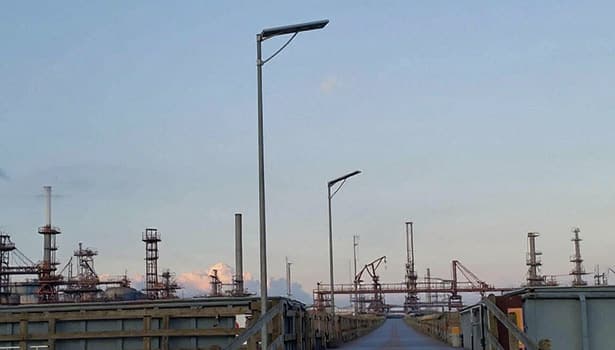
How To Choose Industrial Solar Street Lights?
Optical and Illuminance Requirements are Precisely Matched
Before selecting solar street lighting for industrial zones, the target illuminance should be determined based on the scene: 30-50lux for the main roads in the factory area, 50-100 Lux for loading and unloading areas, ports and other operation areas, and 10-30lux for parking lots and employee passages. At the same time, refer to the photometric curve of the luminaires to avoid blind spots or excessive lighting.
Scientific Selection of LED Light Source Parameters
For LED light sources, it is advisable to give priority to products with a luminous efficacy of ≥120lm/W. Higher luminous efficacy means greater energy efficiency. In terms of color temperature, the working area is suitable for cold white light ranging from 4000K to 5000K to enhance recognition. The employee passage area can be equipped with warm white light ranging from 3000K to 4000K to enhance comfort. The color rendering index (CRI) should be ≥70 to ensure the true presentation of object colors and be suitable for monitoring supplementary lighting scenarios.
Core Indicators for Solar Panel Selection
Monocrystalline modules are preferred for solar panel types, as their conversion efficiency (18%-23%) is higher than that of polycrystalline modules, making them more suitable for industrial scenarios with limited space. The panel area should be calculated based on local sunlight conditions, and the installation inclination Angle should also be taken into account. In the Northern Hemisphere, it is recommended that the inclination Angle be between 5° and 10° of the local latitude to avoid the impact of snow accumulation in winter and direct strong sunlight in summer on efficiency. Before installation, it is necessary to check the surrounding obstructions to ensure that there are no large trees, high-rise buildings or other long-term obstructions.
Battery Type and Capacity Should be Reasonably Designed
LiFePO4 (lithium iron phosphate) batteries are the preferred choice for batteries. Their cycle life (≥2000 times) and safety are far superior to those of traditional lead-acid batteries. The capacity design should meet the lighting requirements during continuous rainy weather. For industrial scenarios, it is recommended to configure a 3-7 day backup energy storage: in rainy areas, it can be designed for 7 days; in dry and less rainy areas, it can be designed for 3-5 days to avoid lighting interruption on cloudy days.
Controller and Intelligent Module Configuration
The controller preferentially selects the MPPT (Maximum Power Point Tracking) type, which has a charging efficiency 10%-15% higher than that of the PWM controller, improving energy utilization efficiency. It is necessary to configure timed dimming and PIR human body sensing functions to achieve "lights on when people come and off when they leave". It is recommended to add a remote monitoring module for industrial scenarios, which supports real-time viewing of equipment status and remote parameter control on mobile phones or computers.
The Structure and Protection Grade are Strictly Controlled
In terms of protection level, the light housing of solar street lighting for industrial zones needs to meet the waterproof standard of IP65 or above. For coastal and dusty areas, it is recommended to choose IP67 level. The anti-collision level (IK) is selected based on the scenario: IK10 level is required for areas prone to impact such as main roads and ports, while IK08 level can be chosen for ordinary areas. Anti-theft design cannot be ignored. It is necessary to configure battery box reinforcement devices and anti-theft bolts to prevent components from being stolen.
Review of Reliability and Warranty Terms
The lifespan of the core components of industrial solar street lights needs to be given special attention: the lifespan of the LED light source should be no less than 50,000 hours, the battery cycle life no less than 2,000 times, and the lifespan of the solar panel no less than 25 years. The warranty terms should clearly state: The light source is guaranteed for more than 5 years, the battery for 3 to 5 years, and the entire light for 2 to 3 years. Give priority to modular design products to facilitate component replacement and maintenance in the later stage.
Industrial Solar Street Lights Design and Installation
Comprehensive Analysis of Point Selection and Occlusion
The installation site should avoid the shadows of large trees and buildings to ensure that the solar panels receive 4 to 6 hours of effective sunlight every day. In remote areas, transportation convenience should be taken into account to avoid the situation where large equipment cannot reach the installation site.
Panel Orientation and Tilt Angle Optimization
It is recommended to install solar panels facing south in the Northern Hemisphere and north in the Southern Hemisphere to receive solar radiation to the greatest extent. The tilt Angle can be slightly adjusted according to the seasons: it should be appropriately reduced in summer and increased in winter to enhance the power generation efficiency in different seasons.
Calculation of Light pole Height and Spacing
Reference for the height and spacing of light posts in different scenarios
- Main roads in the factory area: The height of the lightposts is 8-10 meters, and the spacing is 25-30 meters
- Loading and unloading area, freight yard: The height of the lightposts is 10-12 meters, and the spacing is 20-25 meters
- Parking lot and staff passage: The height of the lightposts is 6-8 meters, and the spacing is 15-20 meters
- Perimeter protection: The height of the lightposts is 6-8 meters, and the spacing is 20-25 meters
Grounding, Conduit and Lightning Protection Design
The risk of lightning strikes is relatively high in industrial areas. The light posts need to be properly grounded, with a grounding resistance of no more than 10Ω. Cable laying should use anti-corrosion cable trays to avoid aging and damage caused by open-air laying. Lightning protection devices should be installed in coastal or areas with frequent lightning to protect electronic components from damage caused by lightning strikes.
Key Points of On-site Commissioning and Acceptance
After the installation of solar street lighting for industrial zones is completed, a night illuminance test should be conducted to ensure that it meets the design standards. Conduct a full charge/power consumption test to verify whether the battery's endurance meets the standards. Check whether the intelligent functions such as dimming, sensing and remote control are operating normally. Acceptance can only be carried out after all indicators are qualified.
Industrial Solar Street Lights Maintenance
Regularly Inspect Core Items
Quarterly routine inspection focus: Clean the dust and bird droppings on the surface of solar panels to ensure power generation efficiency. Check whether the terminal blocks are loose or corroded, and tighten or replace them in time. Check whether the light housing is damaged and whether the waterproof seal is intact.
Annual deep inspection: Check the battery capacity attenuation. If the attenuation exceeds 20%, it needs to be replaced in time. Conduct a comprehensive inspection of the working status of electronic components such as controllers and sensors.
Quick Troubleshooting of Common Faults
- Insufficient lighting brightness: Check if the solar panels are blocked, if the surface is clean, or if the battery capacity has declined.
- The lightdoes not light up: Check for controller faults, loose wiring, or whether the battery voltage is too low.
- Smart function failure: Check if the sensor is damaged and if the network connection of the remote module is normal.
- Battery bulge: Stop using it immediately and replace it to avoid safety risks.
Maintenance Cycle and Efficiency Improvement
Recommended maintenance cycle: quarterly routine inspection + annual in-depth testing. Projects equipped with remote monitoring systems can monitor the status of equipment through real-time data, reducing the frequency of manual inspections by 80% and significantly lowering operation and maintenance costs. The maintenance cycle needs to be shortened in harsh environments (such as coastal areas and dusty regions).
Industrial Solar Street Lights Application Cases
Malaysian Industrial Park Project
This project installs 200 sets of 120W solar street lighting for industrial zones to replace traditional municipal street lights. The total investment is 1.2 million yuan, saving 350,000 yuan in electricity fees annually, reducing operation and maintenance costs by 80%, and the actual investment payback period is 3.5 years. The project has solved the wiring problem in the remote areas of the park and reduced carbon emissions by approximately 180 tons annually.
Construction Project of Remote Mines in China
This mine is located in an area without power grid. 80 sets of 100W solar street lights have been installed for lighting the construction roads and operation areas. From equipment transportation to installation completion, it only takes 15 days, saving 60% of the construction period compared with the traditional wiring solution. The entire industrial solar street light system has been providing normal lighting for five consecutive days of rain, meeting the 24-hour construction needs of the mine.
Urban Commercial Complex Parking Lot Project
150 sets of 80W smart solar street lights have been installed in the parking lot, integrating human body sensing and remote monitoring functions. By adjusting the light as needed, it saves 30% more energy than traditional solar street lights, reducing electricity bills by 220,000 yuan annually. The remote monitoring system enables real-time fault early warning, reducing the labor cost of operation and maintenance by 90%.
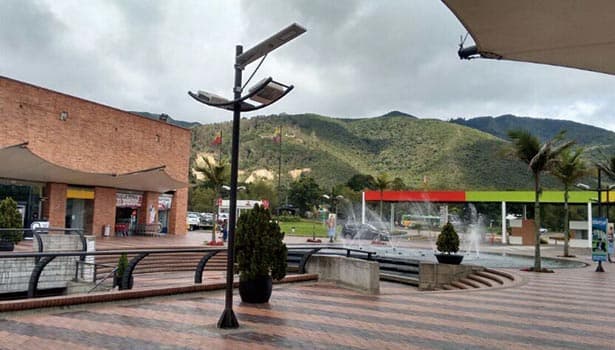
Industrial Solar Street Light FAQ
Q1: Can solar street lights stay on all night during continuous rainy days?
A1: This can be achieved by rationally configuring the battery capacity. It is recommended to design it for 3 to 7 days of rainy weather to meet the lighting needs throughout the night.
Q2: How should batteries be selected for industrial scenarios?
A2: LiFePO4 batteries are preferred as they have a long cycle life, high safety, and are suitable for harsh industrial environments.
Q3: Does the industrial scene require a higher IP/IK level?
A3: Yes, it is recommended that the luminaires of industrial solar street lights be IP65 or above and the light poles be IK08 or above. In special areas, they can be upgraded to IP67 or IK10.
Q4: What are the common pitfalls in the lifespan and warranty of solar street lights?
A4: It is necessary to clearly define the warranty period of the core components of industrial solar street lights to avoid ambiguous expressions of "warranty for the entire light". Focus on confirming the warranty terms of the battery and light source.
Q5: How to calculate the spacing of light poles and illuminance?
A5: Calculate based on the target illuminance of the scene, the luminous efficacy of the lights and the photometric curve, refer to similar project cases, and conduct on-site simulation tests if necessary.
Q6: How to choose between monocrystalline and polycrystalline solar panels?
A6: For industrial scenarios, single crystal boards are preferred as they have higher conversion efficiency and are suitable for areas with limited space or average sunlight conditions.
Q7: Is it necessary to configure the remote monitoring function?
A7: It is recommended to configure it for large-scale industrial applications. It can monitor the status of equipment in real time, reduce inspection costs, and detect faults promptly.
Q8: Do solar street lighting for industrial zones require frequent maintenance after installation?
A8: No. Quarterly cleaning of solar panels and annual battery inspection are sufficient. Configuring remote monitoring can further reduce the frequency of maintenance.

